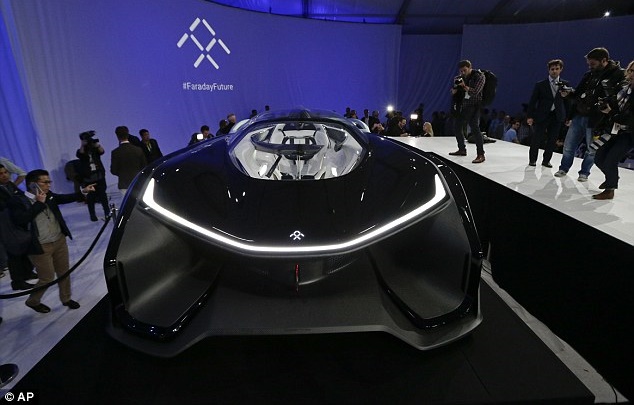Faraday Future will Challenge Tesla with this Electric Batmobile Concept
Faraday Future—a secretive, California-based selectric-vehicle startup that’s been teasing a big reveal for weeks—finally pulled the sheet off its debut concept in Las Vegas Monday night, just ahead of the Consumer Electronics Show. In a tightly packed tent on a rainy Las Vegas night, Faraday Future unveiled its new electric vehicle startup which is still a “couple years” away from launching its first production vehicle, but it’s not afraid of setting up some lofty expectations.
The California-based company, which has backing from Chinese billionaire Jia Yueting, has remained tight-lipped about its plans since its launch 18 months ago. Days ahead of this week’s Consumer Electronics Show in Las Vegas, it still had revealed no details about its debut vehicle, expected for 2017.
“Apple didn’t just transform the phone, they transformed the way we lived our lives, and we want to do that, too,” Faraday Future product architect Nick Sampson told the packed house. “We are embarking on nothing less than a complete rethink of what mobility means.”
The 1,000-horsepower FFZero1 includes the ability to exceeed 200mph (321 kph) and accelerate from zero to 60mph in less than three seconds. It also includes a helmet to provide oxygen and water to the driver. Meanwhile, ‘aero tunnels’ have been incorporated into the design to channel air through the vehicle to reduce drag and cool the batteries.
Faraday’s head of global design Richard Kim called the car something ‘not of this world’, highlighting the strange ‘UFO line’ design
Faraday has been poaching talent from rivals such as Tesla and BMW. The company, based in Gardena, California, outside Los Angeles, now has more than 550 employees. However, the road ahead may not be as smooth as the company claims. The Financial Times recently noted that Faraday Future’s chief battery architect had left after 15 months in the role. The company is only 18 months old.
The new car has been dubbed a ‘Tesla killer’ – and its new factory will be in the same industrial park where a test track for Elon Musk’s Hyperloop will be built. The company’s announcement also came with the revelation that it’s backed by a Chinese billionaire investor who styles himself after Apple’s late Steve Jobs.
‘We plan to revolutionise the automobile industry by creating an integrated, intelligent mobility system that protects the earth and improves the living environment of mankind,’ wrote Jia Yueting, who’s the founder and CEO of the holding company LeTV. Jia is worth $7 billion, according to Forbes, which ranked him as China’s 17th richest person.
He has not commented on Faraday, but has written on his Chinese microblog: ‘We will build the best electric cars to solve the problems of air pollution and traffic jams in China.’
Faraday’s Nick Sampson denied that Faraday’s main competitor would be Tesla, whose premium Model S electric vehicle has shaken up the traditional automaking industry.
Like Tesla, Sampson said, Faraday will target buyers of luxury gasoline-powered cars to expand the still-tiny EV market in the United States.
‘Thinking about us and Tesla squabbling over 1 percent of the market, it’s not really part of the equation,’ he said.

“Tesla and Elon Musk have created something we should all applaud them for,” said Nick Sampson, a senior vice president at Faraday and a former Tesla engineer, onstage at the launch event. “But Tesla was founded in 2003. Five years later, they produced the limited production Roadster, based on the Lotus platform. Seven years after founding, they began work on their first volume production factory and had 600 employees. And then after 9 years, they delivered their first mass market production vehicle. Tesla Motor moved at breakneck speed compared to the rest of the auto industry.”
What makes the company so fast? Sampson explained it’s partially due to its approach to engineering cars with what it calls “Variable Platform Architecture,” or VPA. Sampson explained the fancy term is a modular approach to engineering all the future Faraday vehicles. In a short video, the company explained that its battery is designed on a “string” that allows the company to add or remove batteries based on the layout of the engine, powertrain, wheels or any other internal part. The details of this approach still aren’t entirely clear, but the company promises it’s going to let the company move a lot faster than Tesla ever did.
“With VPA, we can dramatically compress our time to market and reduce our costs,” Sampson boasted.




